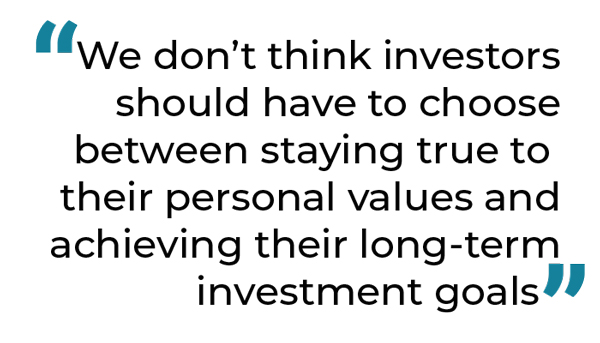ESG Investing: On Par With Value, Growth, or Momentum? (Part 1)

“[B]ecause capital markets pull future risk forward, we will see changes in capital allocation more quickly than we see changes to the climate itself.”
And just like that, Larry Fink, CEO of BlackRock, potentially changed everything. This quote is taken from his letter to CEOs in January, where Fink argues that climate change is the defining determinant of a company’s future success.
We believe his letter foreshadows a world where environmental, social, and governance factors are on a similar playing field as value, quality, and momentum.
Even with the world’s largest asset manager focused on developing sustainable versions of its strategies, much work has to be done for environmental (E), social (S), and governance (G) investing to go from nascent concept to commonly accepted capital allocation method.
Exploring ESG Concepts
ESG investing is based on the idea that a company’s future profitability is based on its corporate sustainability, as measured by ESG risk factors.
We aim to explore concepts around ESG investing in this briefing, which is the first in our three-part series:
- Early obstacles and an entry point (the focus of this post)
- Drivers and barriers
- Implementation within portfolios
Our framework takes cues from a recent whitepaper published by the CFA Institute, “ESG Integration in the Americas: Markets, Practices, and Data”. Their main findings (in bold below) are a suitable framework for us to opine on the topic, though we have rearranged the findings to create a more sensible narrative for these purposes.
Early Obstacles
There is no “one best way” to do ESG integration and no “silver bullet” to ESG integration.
In what is its embryonic stage, ESG investing has no commonly accepted definition, which is detrimental to broader acceptance.
At Blueprint Investment Partners, we are systematic investors who rely on certain variables and factors to develop rules-based models. So, we are eager to see a more mature set of accepted definitions for ESG. (As an aside: More standardization among already mainstay models like, “value,” would also be welcome. We commonly come across ETFs or mutual funds that are marketed as value strategies while having names like Apple or Amazon as their top holdings. But, this is a digression for another blog post.)
The point is, while we think a more developed set of principles for ESG will be accretive for broader acceptance of ESG investing, there’s unlikely to ever be a silver bullet — and that is perfectly fine! As with anything else, the analysis that goes along with ESG factors should be done in a manner that is consistent with the investor’s best interests.
An Entry Point
Governance is the ESG factor most investors are integrating into their process. Environmental and social factors are gaining acceptance but from a low base.
This finding by the CFA Institute is consistent with our experience working with financial advisors. It makes sense, as the origins of corporate governance trace back to the Dutch Republic in the 17th century and, today, it is readily accepted that you don’t necessarily want to invest in a company that’s poorly managed or has unethical people calling the shots.
The important distinction as we see it, however, is that governance is taking on a whole new level of meaning given the Me Too and Black Lives Matter movements, for example.
At Blueprint Investment Partners, our U.S. ESG Strategy seeks diverse companies because study after study has demonstrated that inclusive, well-managed companies outperform their peers. Diversity and inclusion align with our values, which provides a powerful, motivating force for us to continue to innovate and progress along this path.
With respect to environmental and social factors, we are encouraged by the economies of scale we are witnessing in wind, solar, and fuel storage. Renewable energy companies, for example, can present compelling long-term opportunities. We expect both investor interest and profitability to be the drivers for environmental and social factors to gain broader popularity.
Empowering Financial Advisors to Align Clients’ Values & Investing Goals

As pioneers in ESG investing — though it was still called “SRI” or “socially responsible investing” back when my fellow Co-Founder Brandon Langley and I built one of these portfolios at a predecessor firm in 2011 — Blueprint Investment Partners has a lot to offer by way of:
- Defining the asset class (if you may call it that)
- Shaping the way the investing community constructs solutions
- Partnering with financial advisors so they can deliver superior solutions to their clients
Frankly, a big driver behind the launch of the Blueprint U.S. ESG Strategy was our frustration with all the dime-a-dozen options we see in the marketplace! Too often it seems investors have an “either/or choice” in that they can either feel good about their investments by choosing an ESG strategy or they can have a better chance of achieving their investment goals vis-à-vis more risk managed, non-ESG options.
We don’t think investors should have to choose between staying true to their personal values and achieving their long-term investment goals! We believe our process is what bridges the two, by providing a systematic, risk-managed framework for investing in companies that score highly for ESG risk factors.
Keep your eyes peeled for the next installment of our ESG series, where we will examine the drivers and barriers to adoption.

Jon Robinson
Let's Talk
If you’d like to learn more about how an ESG strategy can empower you to align your clients' values with their investing goals
